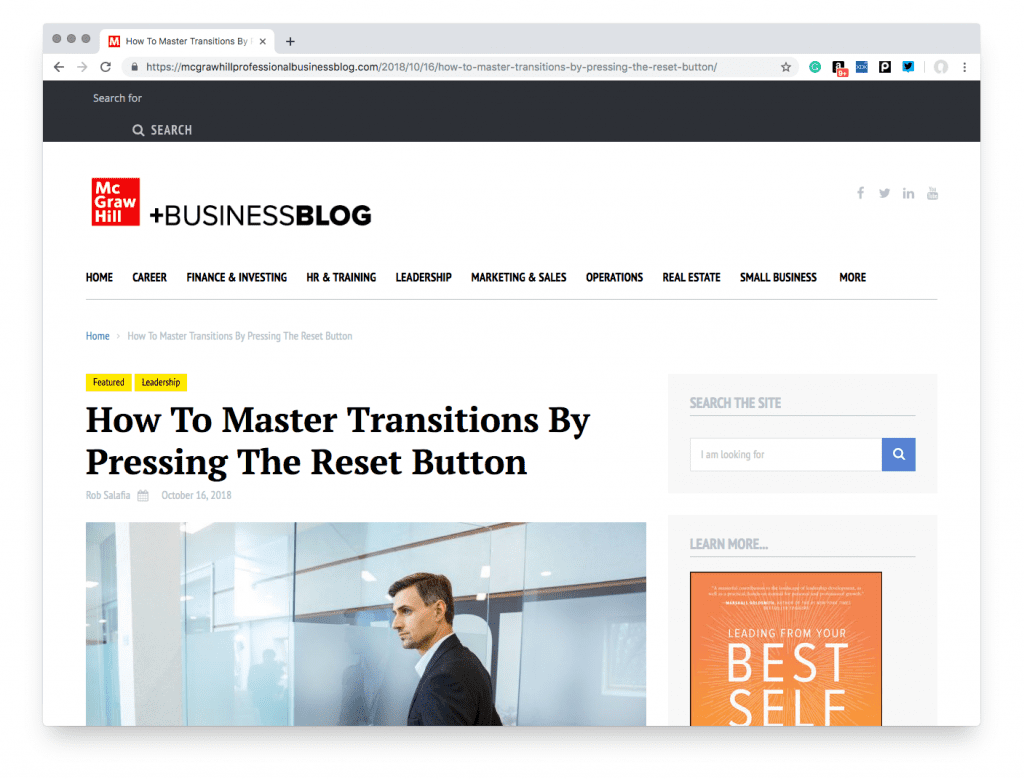
Rob Salafia, an expert on executive presence, explains how to master transitions and become a more effective leader by mentally resetting.
“We do on stage things that are supposed to happen off. Which is a kind of integrity, if you look on every exit as being an entrance somewhere else.” — Tom Stoppard
One of the dilemmas of work and life is the sheer number of tasks that need to get done in a day. Moreover, it appears the more technology introduced to help us get all these things done, the more distracted we become. Learning to navigate transitions in both our work and personal lives is precisely a place where, if we put our attention, we can greatly increase the quality of our relationships, effectiveness, and overall contributions.
How often have you had one of those days where you found yourself going from meeting, to meeting, to meeting, to meeting? Were you able to mentally “reset” before every meeting, or did you find yourself distracted in the next meeting—or longer? Were you able to bring your Best Self to each and every interaction during the day? Probably not.
What would happen if we were to consider what Tom Stoppard suggests in this article’s epigraph—that every exit we make is an entrance to somewhere else? What would this mentality begin to open for us?
I was coaching a young man in Boston to prepare for the eventual succession into leading the family business. The young man was bright, energetic, and full of ideas. His one big issue was that he operated at lightning speed.
One morning, after we had worked together for a month or so, I was sitting in a conference room waiting for him to show up for our session. It was about three minutes past the hour. Suddenly the door flew open, and all I could see was a streak as he sailed past me and landed in a chair across the table. In my mind I imagined papers flying up into the air like you see in the cartoons. I was startled. I smiled, looked at him in the eyes, and asked him if he would be willing to stand up, go back outside, close the door, and put into practice the routine that we had been working on.
The sequence goes like this—Breathe-Connect-Land—and is one that you can put into practice immediately as well. Arrive at the door, pause, get still, and take a deep breath. Grab the handle and connect with the purpose of the meeting. As you breathe out, land inside of yourself with a feeling of confidence. Then, enter into the new space.
As soon as he stepped into the room, he paused took another breath, then connected and landed with me. My whole experience of him changed. He now seemed to have cause and intention. He had a larger sense about him, and his presence increased. He seemed much more confident, open, and ready for our conversation.
What kind of an impression do you think you make in your office when you race from person to person and from meeting to meeting? How do you think people experienced you? How do others likely experience themselves when you are with them? What story might others tell when you’re gone?
The way you navigate your work environment, the energy you embody when you interact with others, and the results that you get need to be assessed in order to find the answers to these questions. By focusing on the actual transition moments during your day, you will start to develop a greater awareness of the interactions you have with others.
Developing a Practice for Making Daily Transitions
- Disengage to re-engage: If someone comes into your office unexpectedly, take a second to stop what you were doing and focus on what you are now doing. Push your chair back, disengage from your work, turn and face the person, take a breath, and engage with him or her.
- Quick switching: When you move from interacting with others and need to refocus on a spreadsheet or an important decision, do a simple math problem in your head. This can be done sitting in your chair or walking down the hall. My favorite is simply to double numbers. Start with two and two is four, four and four is eight, etc. It is easy to get started and then will take slightly more focus with each set. It will only take you 30 seconds but will help you make a better transition.
Rob Salafia is an authority on executive presence and transformative learning experiences. He is a Lecturer and Executive Coach at MIT Sloan School of Management, and Founder of Protagonist Consulting Group. Rob is the author of the new book, Leading From Your Best Self: Develop Executive Poise, Presence, and Influence to Maximize Your Potential, on which this article is based.





















